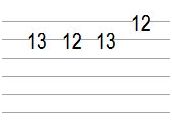by Tom Hess
The first step to playing intense, emotional guitar solos is being able to play a single note with tons of emotion. The next step is taking that single note and expanding from it, so that every guitar lick you play sounds extremely emotional.
Note: You will be lost in this article if you have not already read the third part of this series on how to play lead guitar solos. Read it now, if you have not done so.
To increase the emotional intensity in every single lick of your solos, you have to become aware of how each note feels as it is played above a specific chord/chord progression. Every note you use in your solos has a different function while it is played over different chords, so you can change the way a lick feels emotionally by combining different notes together. Here is an illustration of what I mean: if you are using notes A, B and D over a G major chord, each one of these notes functions differently (A as the second, B as the third and D as the fifth). If you were to use a G note in the place of the D note, it would function differently (as the root) and completely change the overall emotional feeling of the lick.
Visualize painting a picture using different colors. As you use one note over a chord, you only experience a certain emotion (this is the function of that note). Then as you combine this note together with several others, it’s like blending many colors together to create a new one. Just by altering one or two notes in a lick, you can cause a massive change in the way the lick feels.
To hear precisely what this sounds like, watch the video below:
To begin implementing this idea into the licks of your guitar solos, play the .mp3 samples below and use the instructions I made for you. Keep in mind that each sample has been recorded for an entire minute in order to make it easier to complete the steps below:
|
Lick #1 (Hear It) |
Lick #2 (Hear It) |
|
Lick #3 (Hear It) |
Lick #4 (Hear It) |
Step 1– Listen to the .mp3 file above for lick number one and play these chord progression to it:
E minor – A minor – C major – G major -
(Play each chord 5+ times so you can get a good understanding of how each note in the lick feels over it.)
Step 2– Identify how each note in the lick above functions when combined with the chords you just played. Doing this is important for recalling WHY any lick you play feels how it does – giving you the ability to recreate that same feeling in any musical context. This skill is one of the most useful skills to have as a musician… keeping you from becoming the kind of guitarist who wastes time trying to think of a lick that will sound cool over a chord (rather than KNOWING what will sound cool ahead of time).
If you don’t know enough about music theory to understand the above step, study the ideas in this music theory video.
Step3 – Complete the first two steps again by playing the chord progression from step one over the remaining licks.
Step4 – Go back and repeat the first two steps again. Instead of using the chord progression from step one, play these chord progressions over the licks they specify from above:
Play over guitar lick two: C major – E minor – C major – G minor
Play over guitar lick three: F major – G major – A major – E major
Play over guitar lick four: E minor – C major – G major – F major
Once you have finished the steps above, it will be much easier for you to understand how each note you play changes the overall feeling of your guitar licks. It’s crucial that you continue to pay close attention to the notes you use in your solos, so you can always convey the particular emotions you want – instead of mindlessly playing a bunch of memorized licks/patterns and waiting for something to sound good (like a lot of guitar players do).
It will be easy to play with accurate self-expression in your music, when you learn how to turn normal guitar solo licks into awesome guitar solo licks.
When you have the power to make any note sound incredibly expressive and can control the emotions of each note over specific chords, your guitar solos will become like an extension of your soul – making your playing sound highly creative and unique.
To get additional ideas on for how to write and play emotional guitar solos, read this page with methods for playing guitar with emotion.
About The Author:
Tom Hess is a professional touring musician, recording artist and online guitar teacher who teaches guitarists from all over the world in his online guitar lessons. On his website, tomhess.net, you can get additional free tips about guitar playing, guitar playing resources, mini courses and surveys.




